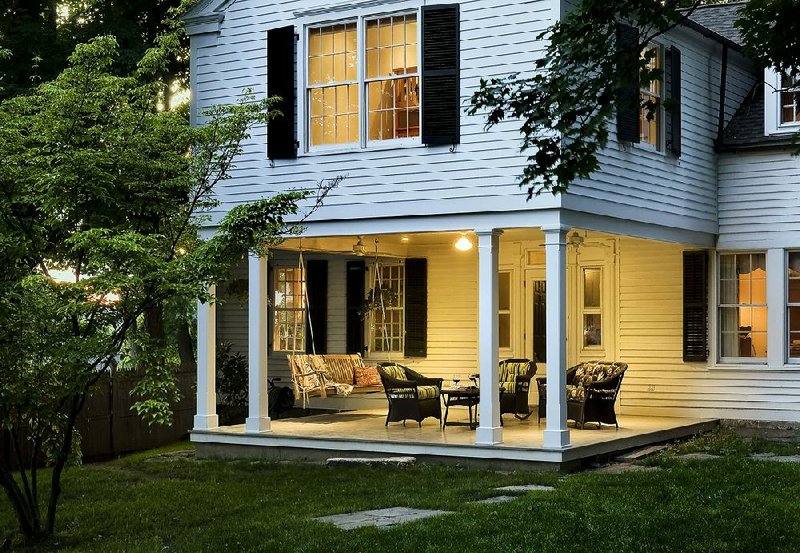When the kids are screaming, the dogs are scuffling, the television is blaring, your spouse is cranky, and your workaday world has frazzled your last nerve, the best medicine is -- the porch. A magical space that lets you both get away and be at home, a porch is life's decompression chamber, the perfect place to let whatever's bugging you float away on the next cloud.
As spring arrives with its sparkling promise of nice weather, the porch in my new home -- and maybe yours -- beckons. And I want to make the most of it. So I go hunting for a book I got years ago On the Porch by architects James Crisp and Sandra Mahoney (Taunton Press, 2007). I take the beautiful picture book out (where else?) on the porch to get inspired, which doesn't take long.
Soon, I'm under the porch's spell.
As I leaf through the book, image after image of porches across America make me feel nostalgic for lives and times I've never even known. I project myself onto these carefree porches where folks do the best kind of nothing, where they rock, knit, whittle, visit, court, shell peas, watch the world go by, shuck corn, bathe the dog, raise pollywogs, cut the kids' hair, hang the laundry, and clean the fish.
I see how front porches are like a house's handshake, a welcome bridge between worlds public and private, connecting a house to the street, to its community. I see how back porches create the perfect stage for morning coffee and family dinners, a perch from which to watch kids play and dogs frolic.
I suddenly have an urgent need to talk about this with someone who cares. I call Crisp, and catch him at his architecture firm in New York, and launch into a lovely conversation about the transformational, life-and-house-changing properties of -- the porch.
"I've always loved porches," says Crisp, who specializes in residential architecture. "Any new home or renovation we do, we try to get a porch in. There aren't many homes that would not benefit."
His book puts it so well: "Both useful and beautiful, porches add character, charm, personality, balance and substance to a house, while distinguishing it from its neighbors."
At his own home in Duchess County, N.Y., Crisp added a porch onto the back of his circa 1790's home. It has become his favorite retreat. "Whenever I walk on the porch at end of the day, with or without a glass of wine, it changes my mood and outlook," he says.
"Best blood pressure medication out there," I say.
"I see the change in others, too," he adds. "People act with a certain decorum inside the house, but discussion and debate are always more relaxed and comfortable out on the porch."
"Which is why Mama used to say, 'Take it outside!'
"I wish someone would do a study," he says, "on the psychological change that happens when you go from inside a house to out on a porch. It's a real change that most people feel whether they recognize it or not."
So grab yourself a glass of lemonade, sit a spell and eavesdrop on our conversation:
Marni: So, what is a porch, by definition?
Crisp: "To me, a porch is any covered area that is outside but attached to the house."
So a lanai, or a covered patio, covered balcony or covered terrace all qualify?
Yes, and porches can be front, side, back, or upstairs. They can be small -- a couple columns supporting a roof by the door to offer protection as one enters a house -- or ample with space for sitting, sipping, dining, visiting, napping, or swinging on a porch swing.
What do you wish more people knew?
That the addition of a porch is probably the least expensive home addition you can make, yet it can transform both the look of your home, and, I'm not kidding, the way you live.
Since your book came out in 2007, what's changed?
The best improvements are in screening products like Phantom Screen, a remote-controlled screen that rolls up and hides under the ceiling beam and rolls down at the touch of a button when you want pest protection.
Weather and pests keep many people from using their porches more. How do you combat those?
If you have a lot of mosquitoes, a screened porch is best. Another way to keep mosquitoes at bay, in addition to using bug repellent, is to have a ceiling fan and crank it on high to knock back the pests. Place ceiling fans over the furniture. To enjoy the porch during cold weather, space heaters are terrific. We also design porches that have Lucite panels that slide in.
How big should a porch be?
We break every rule, but one guideline is, if you want a place for a couple of chairs and a bistro table, to comfortably sit and have room for someone to walk by, the porch should be 9-feet deep.
What about decor?
Wicker furniture, of course, is the traditional standard. But you might also consider furniture that is impervious to moisture, like glass and iron. You want a couple of chairs that perhaps rock, a small table to set a drink on, a porch swing if there's room, a ceiling fan, and good lighting on dimmers.
I'm ready to go out and do nothing.
Syndicated columnist Marni Jameson is the author of three home and lifestyle books, including Downsizing the Family Home -- What to Save, What to Let Go (Sterling Publishing 2016).
HomeStyle on 03/24/2018
